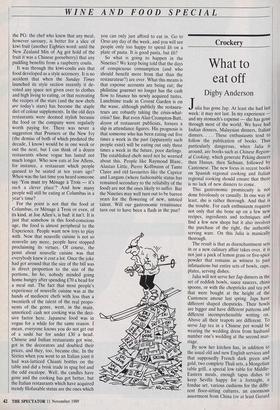Crockery
What to eat off
Digby Anderson
Julia has gone Jap. At least she had last week: it may not last. In my experience and my stomach's expense — she has gone through most of the world. We have had Indian dinners, Malaysian dinners, Italian dinners. . . . These enthusiasms tend to follow the publication of books. Thus particularly dangerous, when Julia is around, are books such as Chinese Region- al Cooking, which generate Peking dinners then Hunan, then Sichuan, followed by Cantonese. The new focus in recent books on Spanish regional cooking and Italian regional cooking should ensure that there is no lack of new dinners to come.
This gastronomic promiscuity is not done frivolously or casually. In one way at least, she is rather thorough. And that is the trouble. For each enthusiasm requires not only that she bone up on a few new recipes, ingredients and techniques and find a few new shops but it also involves the purchase of the right, the authentic serving ware. On this Julia is manically thorough.
The result is that as disenchantment sets in or a new culinary affair takes over, it is not just a pack of lemon grass or five-spice powder that remains as witness to past infatuations but entire sets of bowls, cups, plates, serving dishes.
Julia will not serve her Jap dinners in the set of reddish bowls, sauce saucers, china spoons, or with the chopsticks and tea pot that were bought at the height of the Cantonese amour last spring. Japs have different shaped chopsticks. Their bowls are bigger and have different patterns and different incomprehensible writing on. Above all their teapots are different. To serve Jap tea in a Chinese pot would be wearing the wedding dress from husband number one's wedding at the second mar- riage.
By now her kitchen has, in addition to the usual old and new English services and that supposedly French dark green and gold, two complete Thali sets, a Mongolian table grill, a special low table for Middle- Eastern meals, enough tapas dishes to keep Sevilla happy for a fortnight, a fondue set, various cushions for the diffe- rent floor-sitting cultures, an enormous assortment from China (or at least Gerard Street), oblong American steak plates for oblong American steaks, various things painted in authentic Mexican designs and a huge supply of rotting banana leaves dating back to the South Indian fixation. And now, Pearl Harbor.
All this is for the table only. I do not speak of the special kitchen equipment the woks, paella pans, Jap electric rice- steamers, Chinese bamboo steamers, Mex- ican tortilla presses, the home based pasta factory or the 'special' saucepan without which the pasta cannot be properly boiled, nor the tapes of Fado, Flamenco, Chinese, Indian and Neapolitan songs.
Imperative cooks reject this nonsense. While they welcome the increased range of cuisines and ingredients available, they feel no need to serve them in 'authentic' ware. This partly because they have better things to load into their cupboards and sideboards than twelve Jap china chopstick-rests but more because they recognise that behind the table paraphenalia is the same magical belief which sells cookery books: the su- perstition that buying the book or the service is halfway to cooking the food properly.
Imperative instincts have always been quite the contrary. A Spartan regime of tableware such as used to grace most French homes, seems to act as a better discipline. Most households should use, most of the time, one knife per person, one fork (four prongs), a spoon and — this is the crucial bit — a deep plate, deep enough for sauces, for curries, even for soups, in fact a cross between a soup plate and a dinner plate, all set out on an oil-cloth. To be really old-fashioned French, the plate should have a rim on its bottom, so that having been successively used for all courses up to a salad, it can be turned over and used for cheese and fruit. Again, many French households serving better food than Julia has ever cooked, would be quite happy drinking their coffee out of the same Duralex that contained the wine.
Of course, there are exceptions, times when the Victorian service should come out and, if a lot of far-Asian cooking is done then a basic Chinese set will be useful not only for Chinese but mixed judiciously with the French plates and spoons for Thai, Indonesian and the rest. But that, apart from willingness to use fingers, is the lot.
So, there is another 'idea' for a Christ- mas present you will have to discard — or, rather amend. If you have a friend or relative who does cook well, give him not a set of expensive Jap bowls, but something much more difficult to find though far cheaper, two dozen deep 'French' plates soup plates. They were selling second-hand ones in the surplus shop at the back of Euston station.











































































 Previous page
Previous page